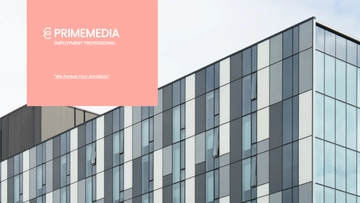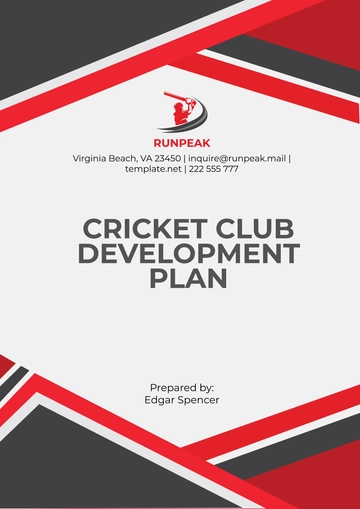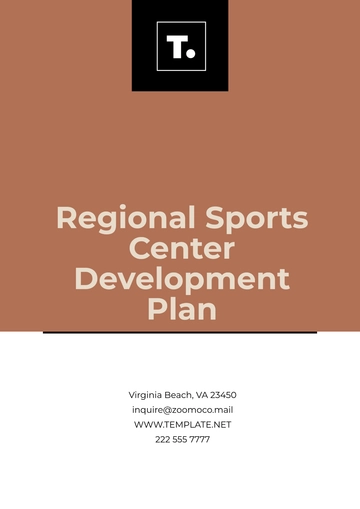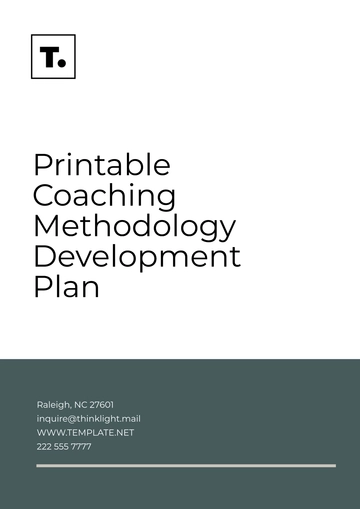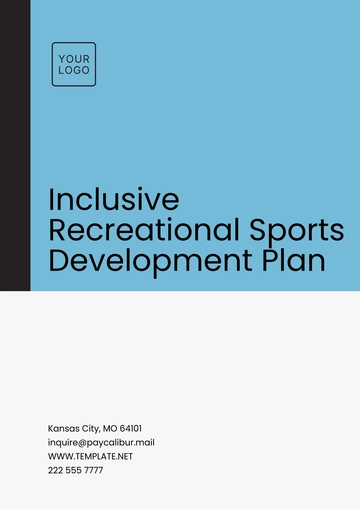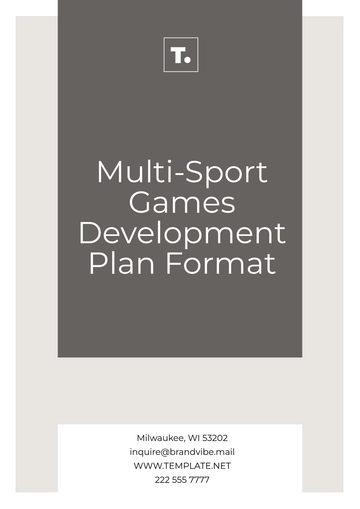Free Regional Sports Center Development Plan

Prepared by: [Your Name]
Date: March 12, 2050
1. Executive Summary
The Regional Sports Center is envisioned as a transformative community hub aimed at fostering physical activity, promoting wellness, nurturing local athletic talent, and enhancing regional tourism. Designed to cater to diverse sports and recreational needs, the center will serve as an inclusive space that adapts to the evolving demands of the community, encouraging participation across all age groups and abilities. The initiative aligns with broader objectives of economic development, public health improvement, and social cohesion.
2. Needs Assessment
2.1 Demographic Analysis
A comprehensive demographic analysis will identify key population segments, focusing on age, gender, and socioeconomic diversity. This ensures that programming and facilities align with the unique requirements and interests of the community. Analysis of current sports participation rates and gaps in recreational access will inform the prioritization of activities and infrastructure.
2.2 Current Facilities Overview
Facility | Location | Sports/Activities | Condition |
|---|---|---|---|
Community Gym | Main Street | Basketball, Volleyball | Fair |
Local Pool | 5th Avenue | Swimming | Good |
Existing facilities reveal a need for modernized, multipurpose spaces to accommodate a wider variety of sports and ensure high-quality experiences for users.
3. Vision and Mission
3.1 Vision
To establish a vibrant, inclusive regional hub that inspires active lifestyles, nurtures talent, and unites the community through sports and recreation.
3.2 Mission
Provide state-of-the-art facilities accessible to all community members.
Foster talent through training, events, and development programs.
Enhance regional pride and economic vitality by hosting large-scale competitions and tournaments.
4. Development Objectives
4.1 Short-Term Goals
Establish partnerships with local schools, sports clubs, and healthcare organizations to ensure community-wide collaboration.
Conduct community surveys and stakeholder consultations to prioritize design and programming needs.
Secure funding sources and begin preliminary planning, including permits and environmental assessments.
4.2 Long-Term Goals
Build a world-class multipurpose sports complex with indoor and outdoor facilities.
Introduce certified training programs for coaches, athletes, and fitness professionals.
Host regional, national, and international events to boost tourism and economic activity.
Develop sustainable management practices for long-term financial and operational success.
5. Design and Facilities
5.1 Indoor Facilities
Multipurpose Sports Arenas: Flexible layouts for basketball, volleyball, tennis, and events, equipped with cutting-edge technology and spectator seating.
Fitness Center: Gymnasium with modern equipment, group fitness studios, and personal training spaces.
Community Rooms: Meeting and activity spaces for workshops, wellness programs, and social events.
5.2 Outdoor Facilities
Soccer and Rugby Fields: Professionally designed turf fields with lighting for evening use.
Track and Field: All-weather jogging tracks, long jump pits, and other amenities.
Recreational Spaces: Open exercise areas, playgrounds, and picnic zones for family-oriented activities.
6. Sustainability and Innovation
Green Building Practices: Use of renewable materials, energy-efficient designs, and solar installations to minimize environmental impact.
Smart Technology Integration: Digital booking systems, energy monitoring, and adaptive lighting to enhance operational efficiency.
Water Recycling: Rainwater harvesting and greywater reuse for landscaping and maintenance.
7. Financial Planning
7.1 Budget Overview
Item | Cost Estimate | Funding Source |
|---|---|---|
Initial Land Acquisition | $2,000,000 | Local Government |
Construction Costs | $10,000,000 | Public-Private Partnership |
Operational Setup | $1,500,000 | Grants and Sponsorships |
7.2 Funding Strategies
The project will leverage diverse funding mechanisms, including:
Public Contributions: Local government support and taxpayer funding.
Private Partnerships: Engagement with businesses for sponsorships and naming rights.
Community Fundraising: Campaigns to involve local residents and businesses.
Grants and Incentives: Applications for regional, state, and national development grants.
8. Implementation Plan
8.1 Phase 1: Planning and Design (Year 1)
Conduct feasibility studies and finalize site selection.
Engage architectural and engineering firms to develop detailed plans.
Secure permits and complete initial fundraising efforts.
8.2 Phase 2: Construction (Year 2–3)
Construct indoor and outdoor facilities in parallel to minimize delays.
Implement sustainability measures during construction.
Continuously monitor progress with regular audits and community updates.
8.3 Phase 3: Operations and Management (Year 4)
Recruit skilled staff and management teams.
Organize soft launches and trial events to fine-tune operations.
Initiate robust marketing campaigns to attract users and events.
9. Community Engagement and Promotion
Outreach Programs: Regular workshops, sports clinics, and free trial sessions for underrepresented groups.
Collaborations: Partner with schools, non-profits, and businesses to expand access and outreach.
Events and Festivals: Host open days, tournaments, and wellness fairs to integrate the center into community life.
10. Risk Management and Mitigation
10.1 Potential Risks
Delays in Construction: Managed through stringent project management protocols and contractor agreements.
Funding Gaps: Mitigated by securing multiple funding streams and contingency plans.
Low Participation Rates: Addressed through targeted outreach, adaptable programs, and periodic feedback reviews.
10.2 Mitigation Strategies
Establish a risk assessment team to address operational and financial challenges proactively.
Build contingency funds into the budget to handle unforeseen expenses.
11. Conclusion
The Regional Sports Center is a bold investment in community health, talent development, and economic growth. Through inclusive design, sustainable practices, and active community engagement, the center will become a cornerstone of regional pride and well-being. Success will be measured through participation rates, satisfaction surveys, and long-term economic and social benefits.
- 100% Customizable, free editor
- Access 1 Million+ Templates, photo’s & graphics
- Download or share as a template
- Click and replace photos, graphics, text, backgrounds
- Resize, crop, AI write & more
- Access advanced editor
Plan your sports center with ease using the Regional Sports Center Development Plan Template from Template.net. Fully customizable and expertly designed, this template streamlines your planning process. It’s editable in our AI Editor Tool, ensuring flexibility and professional results. Perfect for creating detailed, professional development plans tailored to your specific needs.

